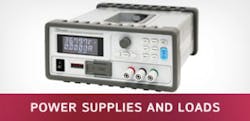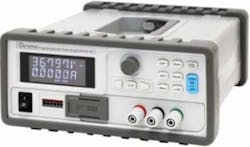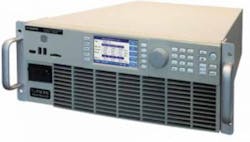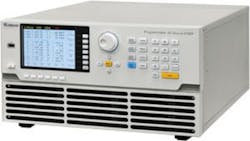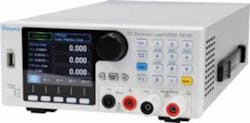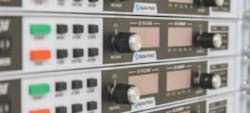From line-voltage simulation to regenerative braking test
Makers of programmable power supplies and loads have been busy on a variety of fronts. They have focused on minimizing ripple and distortion, cutting weight and cost, improving usability and interface options, augmenting line-voltage simulation to facilitate compliance tests, and enhancing measurement capabilities. Applications extend from renewable energy to commercial and military avionics test. The automotive industry also provides plenty of applications for power-conversion products, with electronic loads, for example, helping to measure the impact of regenerative braking on batteries.
You can expect to see programmable power supplies and loads with applicability to military and aerospace test on exhibit at Autotestcon Sept. 17-20 in National Harbor, MD.
For example, “We will be introducing the addition of three new models to our programmable AC power-source product line,” said Steve Grodt, director of business development at Chroma Systems Solutions. “The 6150/7/8/9 (3 kVA, 4.5 kVA, and 6 kVA) are programmable up to 350 V line-to-neutral and capable of delivering either single- or 3-phase output without derating under SCPI program control. Frequency range includes DC and 15 Hz to 2 kHz. These models generate pure sine-waveform output with distortions levels below 0.3% at 50/60 Hz.”
In addition, Grodt said, “The new auto-ranging 62000L programmable DC power supplies (Figure 1) provide low-ripple, low-noise linear performance and fast transient response to meet the requirements of next-generation power electronics…all in a portable, lightweight, and cost-effective package.” Target applications include automotive MCUs and ECUs, wireless communications devices, and semiconductor IC drivers, he said, adding that GPIB and USB come standard, and up to seven units can be connected to achieve greater voltage and current output.
The company also offers electronic loads. “Chroma 63000 benchtop DC electronic loads provide reliable, programmable DC source measurement in a lightweight, compact package,” Grodt said. “What sets these loads apart is that we’ve built-in the same performance features found in our best-selling electronic loads including user-defined waveforms, CZ mode, and dynamic loading.”
Designed for lower-power applications, the 63000 is suitable for testing numerous types of components and devices including switching power supplies, AC/DC power supplies, DC/DC converters, adapters, batteries, and battery chargers, Grodt said. The series offers several models up to 350 W, 150 V, and 60 A with USB, Ethernet, and GBIP support; an LCD; user-defined hot keys; and all necessary protections built-in, he said.
Jon Semancik, director of marketing, AMETEK Programmable Power, said one of his company’s products on exhibit at Autotestcon will be the Sorensen SGX (Figure 2), which he described as a high-performance programmable DC power supply with intuitive touchscreen controls that can provide 5 kW to 30 kW of output power.
“It has exceptional load transient response, low noise, and the highest power density in the industry,” he said, adding that the SGX can be controlled via LXI Ethernet and RS-232 standard control interfaces, as well as through the optional GPIB control interface. In addition, the supplies have an intuitive, easy-to-use front panel touchscreen display. “One of the biggest benefits of using these displays is that it now takes less time to set up the power source and begin running tests,” he said.
Semancik also described the recently launched Asterion DC Series programmable DC power supply as providing maximum power density in a low-profile 1U form factor. Available in three different power levels of 1.7 kW, 3.3 kW, and 5 kW, the 40-V and 60-V models offer a front-panel touchscreen display and standard USB, LXI Ethernet, and RS-232 control interfaces.
The company also offers AC Asterion models. “The Asterion AC 4.5 kVA and 6 kVA programmable AC power sources expand our Asterion AC Series with higher power,” Semancik continued. “Offered in a 4U form factor, these new Asterion AC sources continue to offer the same features and industry-leading power density of the Asterion AC 1U and 2U models.”
Tektronix, too, will be exhibiting power products at Autotestcon, along with oscilloscopes and RF instrumentation (as described on p. 12). Robert Green, marketing manager, said the company’s Keithley power-source portfolio includes general-purpose supplies, 4-quadrant source-measure units (SMUs), battery-simulating supplies, and high-voltage supplies. “Keithley can source from 5 µV to 10,000 V for research, design, and automated test,” he said. “The line also includes 200-W, 250-W, and 750-W electronic loads.”
Products on exhibit at Autotestcon will include the new Keithley 2606B System SourceMeter SMU instrument (Figure 3). “This source houses four independent 20-W bipolar power sources in a very compact 1U high, full-rack-wide instrument,” he said. “Each source can output 20 V at 1 A or 6 V at 3 A. Each source can be a bipolar voltage source or a true, bipolar current source. Precision voltage sourcing provides voltage sensitivity down to 5 µV and precision current sensitivity down to 2 pA. In addition, voltage measurement provides sensitivity to 100 nV and current measurement down to an ultrasensitive 100 fA.”
He said that for high-throughput testing in production, multiple units can be stacked without the need for gaps between units for additional cooling. “The 2606B has Keithley’s test-script processing to speed up testing by enabling the 2606B to execute a test and control for other TSP-enabled instruments,” he said. “Using the built-in intelligence of the 2606B, communication between a controller and the instrumentation is minimized and bus communication time is reduced.” He pointed out that multiple channels can be synchronized with latency under 500 ns. The 2606B features LAN/LXI and USB interfaces along with the TSP-LINK instrument-to-instrument interface.
Tektronix has also recently introduced three new 2230G Series 3-channel programmable power supplies offering total power of 195 W or 375 W—sufficient to test high-power analog circuits, LED drivers, and brushless DC motors, Green said. “All three supplies are built into a 2U high, half-rack-wide enclosure to offer the most power in the least amount of space in a multichannel power supply,” he added. The supplies feature front and rear inputs with remote sensing on each channel as well as USB, GPIB, and RS-232 interfaces. “With three channels, the design engineer has the flexibility to test a bipolar analog circuit and a digital circuit with one space-saving supply,” Green said. “With front and rear inputs, remote sensing, and the compact size, test engineers can save rack space, power three different voltage levels, minimize test-lead length, and make wires less susceptible to interference and damage using the rear connections.”
The need for compactness is a recurring theme in the programmable-power-supply industry. “The 2606 and 2230G Series power supplies were developed to provide multiple channels for testing multiple devices while consuming as little space as possible,” Green said. “Test engineers need to cut their test costs and the size of their test racks to permit testing as many devices as possible in the least amount of space to maximize capacity in limited factory space. Maximizing density has been one of the most significant needs that customers have been requesting. Customers have also been requesting fast current signal capture in their sources, and they have been looking for sources with fast response to load-current changes as they look for an instrument that can more perfectly duplicate the response of a battery.”
Power-conversion trends
Several industry participants cited key trends in the power-supply business. Herman van Eijkelenburg, director of marketing at Pacific Power Source, cited a need for increasing
levels of test power—in the range of 3 to 5 kW—due to the growing electrification of traditionally hydraulic systems in aerospace and autonomous-vehicle applications. In addition, he sees a need for cost containment of support systems and the need to stretch test-system life cycles to longer and longer periods. “This requires support for legacy products by the test-and-measurement manufacturer,” he said. “Pacific Power has a history of supporting its products for several decades—in particular to support our many aerospace and defense customers.”
Referencing specific products and applications, he said, “Pacific Power’s AC and DC power sources are used in a wide range of test applications requiring power levels of 100 W and above, both AC or DC voltage, or a combination thereof. In particular, testing of high-power EV charging systems requiring AC power levels of 6 kVA to over 100 kVA is increasingly needed. With an available power range from 6 kVA to 150 kVA, the new AFX Series (Figure 4) is an excellent solution for electric vehicles, charging systems, and PV power test systems alike.”
For military applications, he said the low-cost 315ASX-UPC3C and 320ASX-UPC3C models offer 3-phase power up to 2 kVA while offering the same performance as higher end ASX models. “For commercial and industrial testing, the new A version of the AFX Series is addressing a wider range of applications with extended voltage and frequency-range capabilities,” he said.
“Pacific’s new generation of AC + DC power sources uses all-digital power-converter stage controls, allowing a three- to fivefold increase in power density compared to competing AC power sources,” he said. “These AFX Series AC and DC power sources allow for easier power upgrades to existing ATE power racks, as no extra rack space is required to significantly increase available test power by replacing older power supplies.”
Inverter test for photovoltaics
“Renewable energy and electric vehicles are currently two of the hot topics in power that we expect to continue into the future,” said Semancik at AMETEK Programmable Power. “We serve those markets in several ways. The TerraSAS photovoltaic simulator, for example, emulates the dynamic electrical behavior of a terrestrial PV solar array. This enables engineers to thoroughly test their inverter designs to ensure that they can wring as much power out of a photovoltaic array as possible. Our MX Series AC power sources are also commonly used as grid simulators to test PV inverters.”
Semancik continued, “We also view electric vehicles as an opportunity for our company. Our power supplies have been used to simulate batteries when testing onboard electronics, and our programmable DC electronic loads have been used to characterize the batteries themselves.”
Semancik said the company’s products find use in commercial and military avionics test, AC power simulation, manufacturing and process control, frequency and voltage conversion, testing to IEC standards, and ATE applications.
Asked what makes the products unique, Semancik said, “AMETEK Programmable Power power sources offer the highest power density in the industry. This allows users to maximize their use of valuable rack space and floor space. In addition, our latest products, such as the Asterion and SGX Series, offer an intuitive touchscreen that allows users to quickly and easily control the power source and set up tests.”
Semancik continued, “Our products are more than just power supplies. They are sophisticated test instruments that supply power to units under test. For example, the SGX Series’ onboard intelligent controls enable sophisticated sequencing and looping of sequences for repetitive testing. When used properly, this can shorten test development time and reduce test development costs.”
SiC and GaN technology
“The most significant trends have been in new, more efficient high-voltage and high-current devices based on SiC and GaN technology,” commented Green at Tektronix. “In addition, the efforts to develop an electric vehicle are challenging the test and measurement industry to develop higher power, high-voltage sources to emulate 400-V and 800-V batteries. Being able to recharge the batteries quickly has resulted in significant activity in high-power charging technology and wireless charging technology. Engineers are looking for higher power sources that can also be electronic loads.” He said the company’s high-voltage power supplies help researchers test leakage current and breakdown voltages on devices such as SiC and GaN transistors and diodes.
He added that customers are also testing power-conversion devices and circuits that draw high current at low voltages. “Electronic loads cannot control a circuit if the voltage is less than a few volts,” he explained. “For those applications, a SourceMeter is needed which can control a load down to 0 V or negative voltages. Those needs require higher power Source-Meters. That is a trend driving manufacturers of sensitive sourcing instrumentation.”
Comprehensive measurement capability
Grodt at Chroma cited several key features of his company’s power-conversion products, including comprehensive measurement capability for its new AC sources. “Chroma 61500/61600 Series AC power sources (Figure 5) have built-in 16-bit measurement circuits and firmware utilities to measure true RMS voltages, currents, true powers, apparent powers, reactive powers, power factors, current crest factors, repetitive peak currents, and inrush currents,” he said. “Using advanced DSP technology, the 61500 can measure THD and up to 50 orders of current harmonics.”
As for DC power supplies, he said, “Autoranging allows for freely adjusting the voltage and current. This feature eliminates the need to manually select the optimum range, allowing all of the power to be available across all voltage and current settings.” He added that the supplies feature fast transient response, with output returning to stability within microseconds after changing load characteristics. Furthermore, low-noise characteristics protect the load or UUT from the interference. “For example, the 62010L-36-7 output voltage noise is lower than 2 mVp-p (from 20 Hz to 20 MHz) under the maximum rated current and maximum output power,” he said, adding, “The autosequencing-programming function built into the 62000L Series allows the user to define and edit the output waveforms with eight steps per cycle.”
In addition, “Chroma 63000 benchtop DC electronic loads (Figure 6) provide reliable, programmable DC source measurement in a lightweight, compact package,” he said. “What set these loads apart is that we’ve built-in the same performance features found in our best-selling electronic loads, including user-defined waveforms, CZ mode, and dynamic loading.”
Grodt also commented on harmonic measurements and the company’s new AC power sources. “The 61500 is capable of simulating voltage dips, interruptions, and variation waveforms for IEC 61000-4-11 precompliance tests and IEC 61000-4-14/IEC 61000-4-28 compliance tests,” he said. “IEC 61000-4-13 standards require interharmonic simulations as well as harmonic waveforms. The Chroma 61500 addresses this standard by allowing users to compose different harmonic components to synthesize various harmonic and distorted waveforms. Applying this advanced feature, users can program sweeping frequency components with the fundamental voltage to find the resonance points of the UUT, providing users with in-depth analytical results.”
Finally, Grodt commented on DC electronic loads for regenerative brake test. “During energy recovery in regenerative braking, quite a bit of high current pulsing gets pushed into the battery which, you guessed it, is a problem for the battery,” he said. Consequently, automotive manufacturers are looking at electronic loads to characterize how this pulsing impacts the batteries.
“Chroma 63200A DC electronic loads are the only loads that operate up to 50 kHz and up to 1,200 V,” Grodt said. “Most loads on the market tap out at 20 kHz at only 1,000 V. Besides the typical DC load functions, Chroma loads include dynamic frequency sweep, digitizing, constant impedance, user-defined waveforms (meaning you can upload captured waveform data into the load), battery discharge test, and programmable load timing. Chroma loads also provide wider operating voltage and current ranges up to 240 kW and the highest accuracy available (voltage at 0.015% + 0.015% full-scale and current at 0.04% + 0.04% full-scale).” He added that Chroma loads can be operated either from their front panels or from an optional soft panel via USB, Ethernet, or GPIB interfaces for remote control and automated testing applications.
High-power AC and DC
In related news, Brian Hsu, product marketing manager at Preen AC Power Corp., said he has identified a trend toward more energy-related testing for electric-vehicle, industrial, energy-storage, photovoltaic, and other applications requiring high-power and clean-power DC or AC sources to verify products. Engineers have traditionally turned to variable transformers or motor-generator sets for adjusting voltage and frequency, he said, but harmonic noise presents issues, outputs can’t be regulated, and such solutions require regular maintenance.
Preen’s latest offerings that can meet such requirements, he said, include the AFV and AFV-P Series power sources, which offer custom output voltage ranges and galvanic isolation (via an output transformer) in one standalone machine with fast delivery times. They find use in providing EMC chamber power and bulk power for industrial production lines, he said, adding that they also find application in burn-in and aging test, laboratory electrical test, and aerospace maintenance.
Also offering AC power supplies is Kikusui. The company describes its PCR-WE/WE2 Series as including PWM inverter-type compact AC power supplies with 15 models offering ratings from 1 kVA to 36 kVA. Models offering 3-kVA and higher ratings are available with 3-phase outputs. The 6-kVA model consists of a 6-kVA power unit in 4U height. The PCR-WE2R model with a 3-phase 200-V input features a regenerative function.
Kikusui also offers the PLZ-5WH Series DC electronic loads, which support a maximum operating voltage of 800 V and maximum power of 100 kW with five units in parallel. The company reported that the instruments can be set for various loading test conditions and cutoff conditions to evaluate large-capacity batteries. Cutoff conditions can be set with respect to Ah, Wh, time, and voltage.
And in May, Magna-Power Electronics announced the availability of a new military-standard-rated ruggedized option for its SL Series and XR Series programmable DC power supplies (Figure 7). Tested to MIL-STD-810G functional shock and vibration specifications, the new ruggedized option is available on 235 models spanning power levels 1.5 kW to 10 kW, voltage levels from 5 VDC to 10,000 VDC, and current levels from 0.2 ADC to 600 ADC.
The ruggedized option, specified at time of order with option code +RUG, allows Magna-Power’s commercial programmable DC power supplies to be integrated in applications that have high levels of shock and vibration. “Magna-Power products are designed for a broad range of applications,” said Grant Pitel, Magna-Power’s vice president of engineering, at the time of the option’s introduction. “The new ruggedization option continues Magna-Power’s design trend, in this case, by allowing the company’s economical commercial off-the-shelf (COTS) power supplies to be applied in high shock and vibration applications that have historically required specialized solutions.”
With the new ruggedized option, the 1U SL Series spanning 1.5 kW to 8 kW and the 2U XR Series spanning 2 kW to 10 kW are rated to comply the following standards:
- MIL-STD-810G CHG1 Method 516.7 Functional Shock, Procedure I, which subjects the product to 40g, 11-ms terminal sawtooth pulse, three shocks in each direction along three mutually perpendicular axes, and
- MIL-STD-810G CHG1 Method 514.7 Vibration, which subjects the product to two hours per axis along three mutually perpendicular axes.
As this article was going to press in early August, Magna-Power announced the delivery of a 1-MW water-cooled DC electronic load to the U.S. Navy, which will use it to research, develop, test, and evaluate the operation of energy-storage modules (ESMs) in a shipboard environment. To meet this requirement, Magna-Power delivered ten of its standard 100-kW WRx Series MagnaLOAD DC electronic loads, configured in two master-slave sets of 500 kW.
The load systems will be part of a real-time hardware-in-the-loop (HIL) simulator, which will drive the MagnaLOADs using a high-speed analog input. A digital simulator will be used in place of the actual electric shipboard equipment to conduct model-based simulation of the shipboard electric load. The MagnaLOADs will mimic discharge profile of the ESM, depending on the components under test and the model being simulated.
Given the nature of these tests, which can last for days, Magna-Power designed its MagnaLOAD products for continuous full-power operation at 50°C ambient operating temperature and cooling water temperature up to 25°C.
And finally, Versatile Power recently announced that its BENCH XR Series 600-W programmable DC power supplies have received certification as LXI-conformant. LXI combines the synchronization and triggering features inherent in VXIbus and IEEE-1588 devices with the benefits of Ethernet and GPIB. LXI test and measurement modules are optimized for use in design validation and manufacturing test systems with LAN connectivity enabling modules to be accessed from anywhere in the world.
The BENCH XR Series incorporates a high-density 1U design that measures 1.73 in. high x 8.82 in. wide x 10.30 in. deep. Each unit weighs 5.8 lbs. The five models in the series offer output power to 600 W, DC output current to 33 A, and DC output voltage to 400 V. The LXI connectivity is included with all BENCH XR Series power supplies at no additional cost.
“The BENCH XR Series is a direct result of our continuing development of extremely compact, digital, and low-cost programmable power supplies capable of high output voltages,” said Jerry Price, CEO of Versatile Power, in a press release. “With the LXI certification, customers now have LAN connectivity, which enables accessibility from anywhere in the world.” EE
For more information:
AMETEK Programmable Power
Chroma Systems Solutions
Kikusui
Magna-Power
Pacific Power Source
Preen AC Power
Tektronix
Versatile Power
About the Author

Rick Nelson
Contributing Editor
Rick is currently Contributing Technical Editor. He was Executive Editor for EE in 2011-2018. Previously he served on several publications, including EDN and Vision Systems Design, and has received awards for signed editorials from the American Society of Business Publication Editors. He began as a design engineer at General Electric and Litton Industries and earned a BSEE degree from Penn State.
